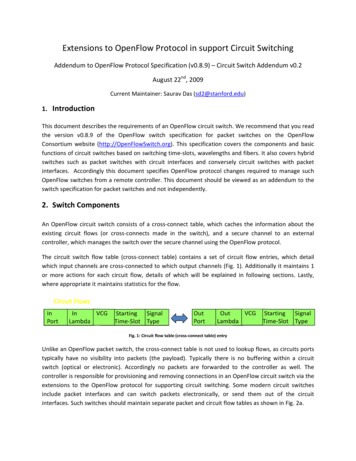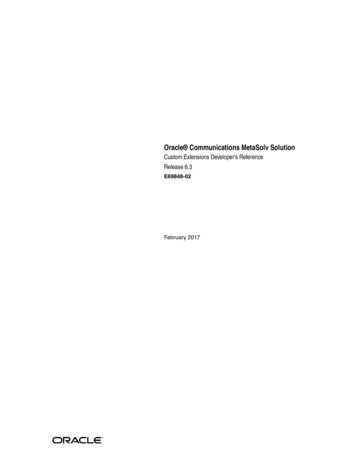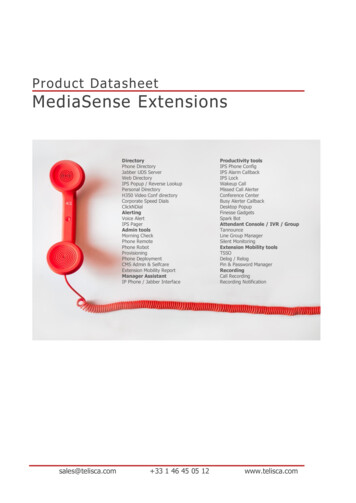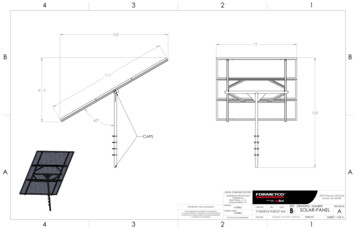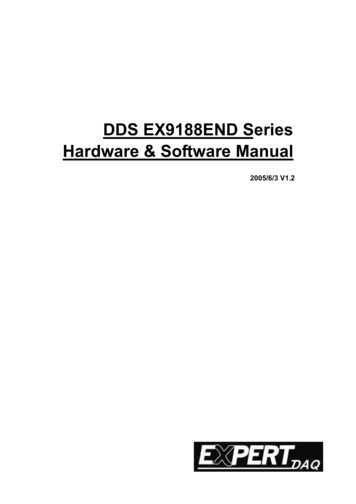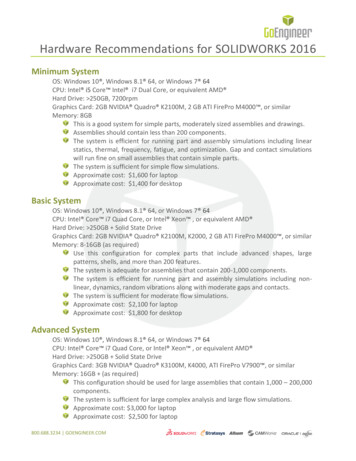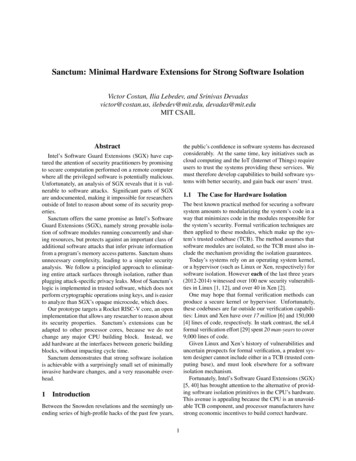
Transcription
Sanctum: Minimal Hardware Extensions for Strong Software IsolationVictor Costan, Ilia Lebedev, and Srinivas Devadasvictor@costan.us, ilebedev@mit.edu, devadas@mit.eduMIT CSAILAbstractthe public’s confidence in software systems has decreasedconsiderably. At the same time, key initiatives such ascloud computing and the IoT (Internet of Things) requireusers to trust the systems providing these services. Wemust therefore develop capabilities to build software systems with better security, and gain back our users’ trust.Intel’s Software Guard Extensions (SGX) have captured the attention of security practitioners by promisingto secure computation performed on a remote computerwhere all the privileged software is potentially malicious.Unfortunately, an analysis of SGX reveals that it is vulnerable to software attacks. Significant parts of SGXare undocumented, making it impossible for researchersoutside of Intel to reason about some of its security properties.Sanctum offers the same promise as Intel’s SoftwareGuard Extensions (SGX), namely strong provable isolation of software modules running concurrently and sharing resources, but protects against an important class ofadditional software attacks that infer private informationfrom a program’s memory access patterns. Sanctum shunsunnecessary complexity, leading to a simpler securityanalysis. We follow a principled approach to eliminating entire attack surfaces through isolation, rather thanplugging attack-specific privacy leaks. Most of Sanctum’slogic is implemented in trusted software, which does notperform cryptographic operations using keys, and is easierto analyze than SGX’s opaque microcode, which does.Our prototype targets a Rocket RISC-V core, an openimplementation that allows any researcher to reason aboutits security properties. Sanctum’s extensions can beadapted to other processor cores, because we do notchange any major CPU building block. Instead, weadd hardware at the interfaces between generic buildingblocks, without impacting cycle time.Sanctum demonstrates that strong software isolationis achievable with a surprisingly small set of minimallyinvasive hardware changes, and a very reasonable overhead.11.1The Case for Hardware IsolationThe best known practical method for securing a softwaresystem amounts to modularizing the system’s code in away that minimizes code in the modules responsible forthe system’s security. Formal verification techniques arethen applied to these modules, which make up the system’s trusted codebase (TCB). The method assumes thatsoftware modules are isolated, so the TCB must also include the mechanism providing the isolation guarantees.Today’s systems rely on an operating system kernel,or a hypervisor (such as Linux or Xen, respectively) forsoftware isolation. However each of the last three years(2012-2014) witnessed over 100 new security vulnerabilities in Linux [1, 12], and over 40 in Xen [2].One may hope that formal verification methods canproduce a secure kernel or hypervisor. Unfortunately,these codebases are far outside our verification capabilities: Linux and Xen have over 17 million [6] and 150,000[4] lines of code, respectively. In stark contrast, the seL4formal verification effort [29] spent 20 man-years to cover9,000 lines of code.Given Linux and Xen’s history of vulnerabilities anduncertain prospects for formal verification, a prudent system designer cannot include either in a TCB (trusted computing base), and must look elsewhere for a softwareisolation mechanism.Fortunately, Intel’s Software Guard Extensions (SGX)[5, 40] has brought attention to the alternative of providing software isolation primitives in the CPU’s hardware.This avenue is appealing because the CPU is an unavoidable TCB component, and processor manufacturers havestrong economic incentives to build correct hardware.IntroductionBetween the Snowden revelations and the seemingly unending series of high-profile hacks of the past few years,1
1.2Intel SGX is Not the AnswerIn summary, while the principles behind SGX havegreat potential, the SGX design does not offer meaningfulisolation guarantees, and the SGX implementation is notopen enough for independent researchers to be able toanalyze its security properties.Unfortunately, although the SGX design includes a vastarray of defenses against a variety of software and physical attacks, it fails to offer meaningful software isolationguarantees. The SGX threat model protects against alldirect attacks, but excludes “side-channel attacks”, evenif they can be performed via software alone.Alarmingly, cache timing attacks require only unprivileged software running on the victim’s host computer, and do not rely on any physical access to the machine. This is particularly concerning in a cloud computing scenario, where gaining software access to the victim’s computer only requires a credit card [42], whereasphysical access is harder, requiring trespass, coercion, orsocial engineering on the cloud provider’s employees.Similarly, in many Internet of Things (IoT) scenarios,the processing units have some amount of physical security, but they run outdated software stacks that have knownsecurity vulnerabilities. For example, an attacker mightexploit a vulnerability in an IoT lock’s Bluetooth stackand obtain software execution privileges, then mount acache timing attack on its access-granting process, andobtain the cryptographic key that opens the lock. In addition to cache timing attacks, indirect software observationof other microarchitectural state, such as the branch history or structured shared by hyper-threading, is also notcovered by Intel’s threat model for SGX.Furthermore, our analysis [14] of SGX reveals that itis impossible for anyone but Intel to reason about SGX’ssecurity properties, because significant implementationdetails are not covered by the publicly available documentation. This is a concern, as the myriad of securityvulnerabilities [17, 19, 44, 55–59] in TXT [23], Intel’sprevious attempt at securing remote computation, showthat securing the machinery underlying Intel’s processorsis incredibly challenging, even in the presence of strongeconomic incentives.If a successor to SGX claimed to protect against cachetiming attacks, substantiating such a claim would requirean analysis of its hardware and microcode, and ensuringthat no implementation detail is vulnerable to cache timing attacks. Barring a highly unlikely shift to open-sourcehardware from Intel, such analysis will never happen.A concrete example: the SGX documentation [24, 26]does not state where SGX stores the EPCM (enclave pagecache map). If the EPCM is stored in cacheable RAM,page translation verification is subject to cache timingattacks. Interestingly, this detail is unnecessary for analyzing the security of today’s SGX implementation, as weknow that SGX uses the operating system’s page tables,and page translations are therefore vulnerable to cachetiming attacks. The example does, however, demonstratethe fine nature of crucial details that are simply undocumented in today’s hardware security implementations.1.3Sanctum ContributionsOur main contribution is a software isolation scheme thataddresses the issues raised above: Sanctum’s isolationprovably defends against known software side-channel attacks, including cache timing attacks and passive addresstranslation attacks. Sanctum is a co-design that combines minimal and minimally invasive hardware modifications with a trusted software security monitor thatis amenable to rigorous analysis and does not performcryptographic operations using keys.We achieve minimality by reusing and lightly modifying existing, well-understood mechanisms. For example, our per-enclave page tables implementation uses thecore’s existing page walking circuit, and requires verylittle extra logic. Sanctum is minimally invasive becauseit does not require modifying any major CPU buildingblock. We only add hardware to the interfaces betweenblocks, and do not modify any block’s input or output.Our use of conventional building blocks limits the effortneeded to validate a Sanctum implementation.We demonstrate that memory access pattern attacksby malicious software can be foiled without incurringunreasonable overheads. Our hardware changes are smallenough to present the added circuits, in their entirety,in Figures 9 and 10. Sanctum cores have the sameclock speed as their insecure counterparts, as we do notmodify the CPU core critical execution path. Using astraightforward page-coloring-based cache partitioningscheme with Sanctum adds a few percent of overhead inexecution time, which is orders of magnitude lower thanthe overheads of the ORAM schemes [22, 48] that areusually employed to conceal memory access patterns.All layers of Sanctum’s TCB are open-sourcedat https://github.com/pwnall/sanctum and unencumbered by patents, trade secrets, or other similar intellectual property concerns that would disincentivize security researchers from analyzing it. Our prototype targetsthe Rocket Chip [33], an open-sourced implementation ofthe RISC-V [52, 54] instruction set architecture, whichis an open standard. Sanctum’s software stack bears theMIT license.To further encourage analysis, most of our securitymonitor is written in portable C which, once rigorouslyanalyzed, can be used across different CPU implementations. Furthermore, even the non-portable assembly codecan be reused across different implementations of thesame architecture. In comparison, SGX’s microcode isCPU model-specific, so each micro-architectural revision2
would require a separate verification effort.2widely deployed in today’s mainstream computers, dueto its approach of trying to add security to a successfulCPU product. After falling victim to attacks [56, 59]where a malicious OS directed a network card to accessdata in the protected VM, a TXT revision introducedDRAM controller modifications that selectively blockDMA transfers, which Sanctum also does.Intel’s SGX [5, 40] adapted the ideas in Aegis andXOM to multi-core processors with a shared, coherentlast-level cache. Sanctum draws heavy inspiration fromSGX’s approach to memory access control, which doesnot modify the core’s critical execution path. We reverseengineered and adapted SGX’s method for verifying anOS-conducted TLB shoot-down. At the same time, SGXhas many security issues that are solved by Sanctum,which are stated in this paper’s introduction.Iso-X [20] attempts to offer the SGX security guarantees, without the limitation that enclaves may only beallocated in a DRAM area that is carved off exclusivelyfor SGX use, at boot time. Iso-X uses per-enclave pagetables, like Sanctum, but its enclave page tables requirea dedicated page walker. Iso-X’s hardware changes addoverhead to the core’s cycle time, and do not protectagainst cache timing attacks.SecureME [13] also proposes a co-design of hardwaremodifications and a trusted hypervisor for ensuring software isolation, but adapts the on-chip mechanisms generally used to prevent physical attacks, in order to protectapplications from an untrusted OS. Just like SGX, SecureME is vulnerable to memory access pattern attacks.The research community has brought forward variousdefenses against cache timing attacks. PLcache [31, 51]and the Random Fill Cache Architecture (RFill, [38])were designed and analyzed in the context of a smallregion of sensitive data, and scaling them to protect apotentially large enclave without compromising performance is not straightforward. When used to isolate entireenclaves in the LLC, RFill performs at least 37%-66%worse than Sanctum.RPcache [31, 51] trusts the OS to assign different hardware process IDs to mutually mistrusting entities, and itsmechanism does not directly scale to large LLCs. Thenon-monopolizable cache [16] uses a well-principled partitioning scheme, but does not completely stop leakage,and relies on the OS to assign hardware process IDs.CATalyst [37] trusts the Xen hypervisor to correctly tameIntel’s Cache Allocation Technology into providing cachepinning, which can only secure software whose code anddata fits into a fraction of the LLC.A fair share of the cache timing attack countermeasurescited here focus on protecting relatively small pieces ofcode and data that are loosely coupled to the rest of theapplication. The countermeasures are suitable for cryptographic keys and the algorithms that operate on them, butRelated WorkSanctum’s main improvement over SGX is preventingsoftware attacks that analyze an isolated container’s memory access patterns to infer private information. We areparticularly concerned with cache timing attacks [8], because they can be mounted by unprivileged software sharing a computer with the victim software.Cache timing attacks are known to retrieve cryptographic keys used by AES [9], RSA [11], Diffie-Hellman[30], and elliptic-curve cryptography [10]. While earlyattacks required access to the victim’s CPU core, recentsophisticated attacks [39, 61] target the last-level cache(LLC), which is shared by all cores in a socket. Recently, [41] demonstrated a cache timing attack that usesJavaScript code in a page visited by a web browser.Cache timing attacks observe a victim’s memory access patterns at cache line granularity. However, recentwork shows that private information can be gleaned evenfrom the page-level memory access pattern obtained bya malicious OS that simply logs the addresses seen byits page fault handler [60]. Moreover, much like cachetiming attacks, indirect observation of other hardwarestructures [32] may allow an adversary to glean private information without violating memory access protections.XOM [34] introduced the idea of having sensitive codeand data execute in isolated containers, and placed theOS in charge of resource allocation without trusting it.Aegis [49] relies on a trusted security kernel, handlesuntrusted memory, and identifies the software in a container by computing a cryptographic hash over the initialcontents of the container. Aegis also computes a hash ofthe security kernel at boot time and uses it, together withthe container’s hash, to attest a container’s identity to athird party, and to derive container keys. Unlike XOMand Aegis, Sanctum protects the memory access patternsof the software executing inside the isolation containersfrom software threats.Sanctum only considers software attacks in its threatmodel (§ 3). Resilience against physical attacks can beadded by augmenting a Sanctum processor with the countermeasures described in other secure architectures, withassociated increased performance overheads. Aegis protects a container’s data when the DRAM is untrustedthrough memory encryption and integrity verification;these techniques were adopted and adapted by SGX. Ascend [21] and GhostRider [36] use Oblivious RAM [22]to protect a container’s memory access patterns againstadversaries that can observe the addresses on the memorybus. An insight in Sanctum is that these overheads areunnecessary in a software-only threat model.Intel’s Trusted Execution Technology (TXT) [23] is3
do not scale to larger codebases. This is a questionable approach, because crypto keys have no intrinsic value, andare only attacked to gain access to the sensitive data thatthey protect. For example, in a medical image processingapplication, the sensitive data may be patient X-rays. Ahigh-resolution image uses at least a few megabytes, sothe countermeasures above will leave the X-rays vulnerable to cache timing attacks while they are operated on byimage processing algorithms.Sanctum uses very simple cache partitioning [35] basedon page coloring [27, 50], which has proven to have reasonable overheads. It is likely that sophisticated schemeslike ZCache [45] and Vantage [46] can be combined withSanctum’s framework to yield better performance.3like [11], where the victim application leaks informationvia its public API, and the leak occurs even if the victim runs on a dedicated machine. We do protect againstattacks like Flush Reload [61], which exploit shared hardware resources to interact with the victim via methodsoutside its public API.Sanctum also defeats attackers who aim to compromisean OS or hypervisor by running malicious applicationsand enclaves. This addresses concerns that enclaves provide new attack vectors for malware [15, 43]. We assumethat the benefits of meaningful software isolation outweigh enabling a new avenue for frustrating malwaredetection and reverse engineering [18].Lastly, Sanctum protects against a malicious computerowner who attempts to lie about the security monitor running on the computer. Specifically, the attacker aims toobtain an attestation stating that the computer is runningan uncompromised security monitor, whereas a differentmonitor had been loaded in the boot process. The uncompromised security monitor must not have any knownvulnerability that causes it to disclose its cryptographickeys. The attacker is assumed to know the target computer’s architecture and micro-architecture, and is allowedto run any combination of malicious security monitor, hypervisor, OS, applications and enclaves.We do not prevent timing attacks that exploit bottlenecks in the cache coherence directory bandwidth or inthe DRAM bandwidth, deferring these to future work.Sanctum does not protect against denial-of-service(DoS) attacks by compromised system software: a malicious OS may deny service by refusing to allocate anyresources to an enclave. We do protect against maliciousenclaves attempting to DoS an uncompromised OS.We assume correct underlying hardware, so we do notprotect against software attacks that exploit hardware bugs(fault-injection attacks), such as rowhammer [28, 47].Sanctum’s isolation mechanisms exclusively target software attacks. § 2 mentions related work that can harden aSanctum system against some physical attacks. Furthermore, we consider software attacks that rely on sensordata to be physical attacks. For example, we do not address information leakage due to power variations, because software would require a temperature or currentsensor to carry out such an attack.Threat ModelSanctum isolates the software inside an enclave fromother software on the same computer. All outside software, including privileged system software, can only interact with an enclave via a small set of primitives providedby the security monitor. Programmers are expected tomove the sensitive code in their applications into enclaves.In general, an enclave receives encrypted sensitive information from outside, decrypts the information and performs some computation on it, and then returns encryptedresults to the outside world.For example, medical imaging software would use anenclave to decrypt a patient’s X-ray and produce a diagnostic via an image processing algorithm. Applicationcode that does not handle sensitive data, such as receiving encrypted X-rays over the network and storing theencrypted images in a database, would not be enclaved.We assume that an attacker can compromise any operating system and hypervisor present on the computerexecuting the enclave, and can launch rogue enclaves.The attacker knows the target computer’s architecture andmicro-architecture. The attacker can analyze passivelycollected data, such as page fault addresses, as well asmount active attacks, such as direct or DMA memoryprobing, and cache timing attacks.Sanctum’s isolation protects the integrity and privacyof the code and data inside an enclave against any practical software attack that relies on observing or interactingwith the enclave software via means outside the interface provided by the security monitor. In other words,we do not protect enclaves that leak their own secretsdirectly (e.g., by writing to untrusted memory) or by timing their operations (e.g., by modulating their completiontimes). In effect, Sanctum solves the security problemsthat emerge from sharing a computer among mutuallydistrusting appl
clock speed as their insecure counterparts, as we do not modify the CPU core critical execution path. Using a straightforward page-coloring-based cache partitioning scheme with Sanctum adds a few percent of overhead in execution time, which is orders of magnitude lower


